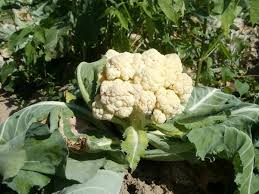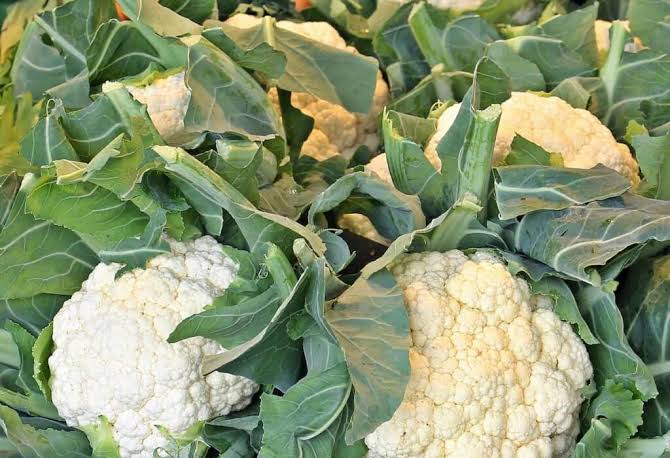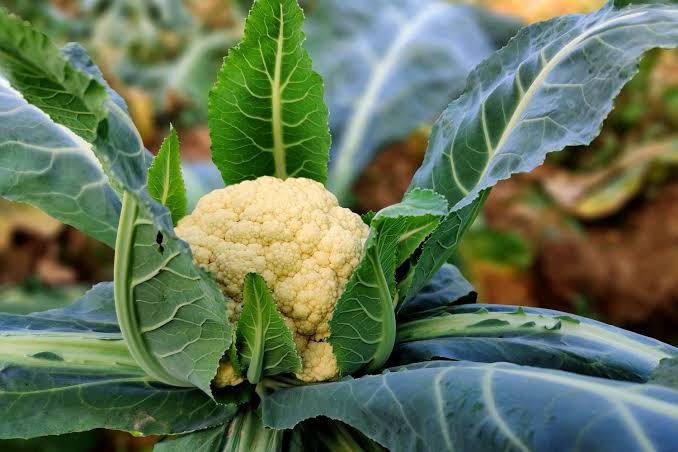Cauliflower is a versatile vegetable that comes from the same family as broccoli and cabbage. It’s like a white-flowered cousin in the garden. When you look at it, you see a bunch of tight, compact florets all huddled together. But there’s so much more to this humble veggie than meets the eye.
Imagine a vegetable that can transform itself into various dishes, playing the chameleon in your kitchen. Cauliflower is that culinary wizard. Want something comforting? Boil or steam it and mash it up for a creamy, dreamy side dish. Craving something crunchy? Cut it into florets, give them a light toss in oil and spices, then pop them in the oven for crispy cauliflower bites.
But wait, there’s more! Cauliflower is like a blank canvas for flavors. It soaks up whatever you throw at it, whether it’s a rich cheese sauce, aromatic Indian spices, or a zesty lemon dressing. This makes it a go-to for creative cooks looking to elevate their recipes.
Now, let’s talk about health. Cauliflower is a nutritional powerhouse. Packed with vitamins, especially vitamin C, it’s like a protective shield for your immune system. Fiber? Check. Antioxidants? Double-check. Low in calories? Triple-check. It’s a guilt-free addition to your plate, offering a satisfying crunch without weighing you down.
Have you heard of cauliflower rice? It’s like rice but made from cauliflower. A sneaky way to add more veggies to your meal without sacrificing texture or taste. And let’s not forget cauliflower pizza crust – a game-changer for those watching their carb intake.
Cauliflower is also an eco-friendly choice. It’s a cool-season crop, meaning it thrives in cooler temperatures, reducing the need for excessive water or energy. Plus, it’s a team player in crop rotation, promoting soil health.
In addition, cauliflower is not just a vegetable; it’s a culinary magician, a nutritional powerhouse, and an eco-friendly ally. So, the next time you see that white head in the grocery store, remember all the delicious possibilities it holds and bring it home to work its versatile magic in your kitchen.
Read Also: Himalayan Cats (Felis catus) Description and Complete Care Guide
Growing and Care Guide of Cauliflower

Growing and caring for cauliflower can be a rewarding experience. Here’s a simple guide to help you nurture this versatile vegetable in your own garden.
1. Choosing the Right Spot: Cauliflower enjoys full sunlight, so find a spot in your garden that receives at least 6 hours of sunlight each day. Ensure the soil is well-draining and rich in organic matter.
2. Planting: Plant cauliflower seeds indoors about 6-8 weeks before your region’s last expected frost. Once the seedlings are sturdy enough, transplant them into the garden, spacing them about 18-24 inches apart. If you prefer, you can also buy young plants from a nursery and transplant them directly into your garden.
3. Watering: Cauliflower needs consistent moisture, so water the plants regularly. Keep the soil evenly moist, but be cautious not to overwater, as cauliflower doesn’t like waterlogged conditions.
4. Fertilizing: Use a balanced fertilizer when planting and then side-dress with nitrogen-rich fertilizer once the plants are established. This helps promote healthy leafy growth, which is crucial for developing a robust cauliflower head.
5. Weeding: Keep the area around your cauliflower plants free from weeds. Weeds compete for nutrients and water, and you want your cauliflower to have all the resources it needs to thrive.
6. Pest Control: Cauliflower is susceptible to certain pests, such as cabbage worms. Regularly check the undersides of leaves for eggs and larvae, and remove them by hand. Consider using organic pest control methods if needed.
7. Protecting Against Extreme Temperatures: Cauliflower prefers cool temperatures. If you’re growing it in a warm climate, plant it in a location that provides some shade during the hottest part of the day. If temperatures drop unexpectedly, consider covering the plants with a light cloth to protect them from frost.
8. Harvesting: Keep an eye on your cauliflower as it grows. Once the head reaches a good size and is still compact, it’s time to harvest. Cut the head from the stem, leaving a few leaves around the base to protect the curd.
9. Storing: Store harvested cauliflower in the refrigerator. It’s best to use it within a week for optimal freshness. If you have a surplus, consider blanching and freezing cauliflower for longer storage.
By following these simple guidelines, you can enjoy the satisfaction of growing your own cauliflower and savor the delicious rewards of your efforts in the kitchen.
Read Also: Russian Blues (Felis catus) Cats Description and Complete Care Guide
Uses of Cauliflower

Cauliflower is a versatile vegetable that can be used in a variety of delicious ways. Here are some creative uses to make the most of this versatile veggie:
1. Cauliflower Rice: Grate or process cauliflower into small, rice-sized pieces. Sauté or steam them for a low-carb alternative to traditional rice. It’s a great option for those looking to reduce their carb intake.
2. Cauliflower Mash: Boil or steam cauliflower until tender, then mash it for a lighter, healthier alternative to mashed potatoes. Add garlic, butter, and your favorite herbs for extra flavor.
3. Cauliflower Pizza Crust: Blend cauliflower into a fine texture, mix it with cheese, egg, and seasoning, then bake to create a gluten-free pizza crust. Top with your favorite pizza toppings for a healthier pizza option.
4. Cauliflower Soup: Puree cauliflower with broth, onions, and other veggies to make a creamy and nutritious soup. It’s a comforting option, especially during colder seasons.
5. Roasted Cauliflower: Toss cauliflower florets in olive oil and your favorite seasonings, then roast them until golden brown. This simple method enhances the natural sweetness and creates a delicious side dish or snack.
6. Cauliflower Stir-Fry: Include cauliflower in stir-fries with other colorful vegetables, tofu, or meat. Its mild flavor allows it to absorb the savory tastes of your stir-fry sauce.
7. Cauliflower Buffalo Bites: Coat cauliflower florets in a spicy buffalo sauce, then bake until crispy. Serve with a side of ranch or blue cheese dressing for a tasty and healthier alternative to traditional buffalo wings.
8. Cauliflower Tacos: Roast or grill cauliflower and use it as a filling for tacos. Top with salsa, guacamole, and other favorite taco toppings for a delicious meatless option.
9. Cauliflower Curry: Add cauliflower to your favorite curry recipe for a hearty and nutritious twist. It absorbs the flavors of the curry, making it a tasty addition.
10. Cauliflower Steaks: Slice cauliflower into thick steaks, brush with olive oil, and roast or grill until tender. Season with your favorite herbs and spices for a satisfying and visually appealing main dish.
These are just a few ideas to inspire your culinary creativity with cauliflower. With its adaptable nature, cauliflower can be a healthy and tasty addition to a wide range of dishes.
Where to Find Cauliflower near Me/You
Cauliflower is commonly available in various locations, making it easy to find for most consumers. Here are some places where you can locate cauliflower:
1. Grocery Stores: Visit your local grocery store or supermarket, where cauliflower is typically found in the fresh produce section. It is often sold either as whole heads or pre-cut florets.
2. Farmers’ Markets: Explore farmers’ markets in your area, especially during the cauliflower’s peak season. Local farmers often offer fresh, locally grown produce.
3. Health Food Stores: Check health food stores or specialty markets that focus on organic or natural products. They may carry organic cauliflower or cauliflower alternatives, such as colored varieties.
4. Supercenters and Hypermarkets: Larger retail stores, such as supercenters and hypermarkets, usually have well-stocked produce sections where you can find cauliflower.
5. Online Grocery Delivery Services: Consider using online grocery delivery services or ordering through grocery apps. Many supermarkets offer online platforms where you can choose and order cauliflower for delivery to your doorstep.
6. Local Farms and CSA (Community Supported Agriculture) Programs: Explore local farms or participate in CSA programs, where you can receive fresh produce directly from the farm. Some farms allow you to pick up a variety of vegetables, including cauliflower, on a regular basis.
7. Wholesale Stores: If you prefer buying in larger quantities, wholesale stores may carry cauliflower in bulk. This is suitable for those who enjoy meal prepping or have larger households.
8. International or Ethnic Grocery Stores: Check international or ethnic grocery stores, as cauliflower is a versatile ingredient used in various cuisines. You might find different varieties or preparations of cauliflower in these stores.
Remember to choose cauliflower heads that are firm, compact, and have a creamy white color. Avoid those with brown spots or discoloration. Additionally, the availability of cauliflower may vary based on the season and your geographical location.
Read Also: How to Make Homemade Pasta

